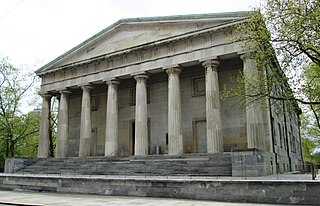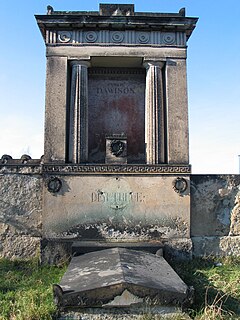 W
WThe American Renaissance was a period of American architecture and the arts from 1876 to 1917, characterized by renewed national self-confidence and a feeling that the United States was the heir to Greek democracy, Roman law, and Renaissance humanism. The era spans the period between the Centennial Exposition and the United States' entry into World War I.
 W
WBeaux-Arts architecture was the academic architectural style taught at the École des Beaux-Arts in Paris, particularly from the 1830s to the end of the 19th century. It drew upon the principles of French neoclassicism, but also incorporated Gothic and Renaissance elements, and used modern materials, such as iron and glass. It was an important style in France until the end of the 19th century. It also had a strong influence on architecture in the United States because of the many prominent American architects who studied at the École des Beaux-Arts, including Henry Hobson Richardson, John Galen Howard, Daniel Burnham, and Louis Sullivan.
 W
WThe Greek Revival was an architectural movement of the late 18th and early 19th centuries, predominantly in Northern Europe and the United States. It revived the style of ancient Greek architecture, in particular the Greek temple, with varying degrees of thoroughness and consistency. A product of Hellenism, it may be looked upon as the last phase in the development of Neoclassical architecture, which had for long mainly drawn from Roman architecture. The term was first used by Charles Robert Cockerell in a lecture he gave as Professor of Architecture to the Royal Academy of Arts, London in 1842.
 W
WGreek Revival was an architectural style popular in the United States and Canada from about 1800 to 1860. Marcus Whiffen states that the "first building in the United States to incorporate a Greek order was the Bank of Pennsylvania in Philadelphia, designed by Benjamin Henry Latrobe in 1798". Talbot Hamlin says that "The period called 'Greek Revival,' extending roughly from 1820 to 1860."
 W
WNeoclassical Hellenism is a term introduced primarily during the European Romantic era by Johann Joachim Winckelmann.
 W
WNéo-Grec was a Neoclassical Revival style of the mid-to-late 19th century that was popularized in architecture, the decorative arts, and in painting during France's Second Empire, or the reign of Napoleon III (1852–1870). The Néo-Grec vogue took as its starting point the earlier expressions of the Neoclassical style inspired by 18th-century excavations at Pompeii, which resumed in earnest in 1848, and similar excavations at Herculaneum. The style mixed elements of the Graeco-Roman, Pompeian, Adam and Egyptian Revival styles into "a richly eclectic polychrome mélange." "The style enjoyed a vogue in the USA, and had a short-lived impact on interior design in England and elsewhere."
 W
WNovecento Italiano was an Italian artistic movement founded in Milan in 1922 to create an art based on the rhetoric of the fascism of Mussolini.
 W
WThe return to order was a European art movement that followed the First World War, rejecting the extreme avant-garde art of the years up to 1918 and taking its inspiration from traditional art instead. The movement was a reaction to the war. Cubism was partially abandoned even by its co-creator Picasso. Futurism, which had praised machinery, dynamism, violence and war, was rejected by most of its adherents. The return to order was associated with a revival of classicism and realistic painting.
 W
WSecond Empire architecture in Europe is an architectural style rooted in the 16th-century Renaissance, which grew to its greatest popularity in Europe in the second half of the nineteenth century and early years of the twentieth century. As the style evolved from its origins, it acquired a mix of European styles, most notably the Baroque, often combined with mansard roofs and low, square based domes. It derived its name from the era of the Second French Empire.
 W
WSecond Empire, in the United States and Canada, is an architectural style most popular between 1865 and 1900. Second Empire architecture developed from the redevelopment of Paris under Napoleon III's Second French Empire and looked to French Renaissance precedents. It was characterized by a mansard roof, elaborate ornament, and strong massing and was notably used for public buildings as well as commercial and residential design.
 W
WSecond Empire style, also known as the Napoleon III style, was a highly eclectic style of architecture and decorative arts, which used elements of many different historical styles, and also made innovative use of modern materials, such as iron frameworks and glass skylights. It flourished during the reign of Emperor Napoleon III in France (1852–1871) and had an important influence on architecture and decoration in the rest of Europe and the United States. Major examples of the style include the Opéra Garnier (1862–1871) in Paris by Charles Garnier, the Bibliothèque nationale de France, the Church of Saint Augustine (1860–1871), and South Hall (1873) at the University of California, Berkeley. The architectural style was closely connected with Haussmann's renovation of Paris carried out during the Second Empire; the new buildings, such as the Opéra, were intended as the focal points of the new boulevards.
 W
WWeimar Classicism was a German literary and cultural movement, whose practitioners established a new humanism from the synthesis of ideas from Romanticism, Classicism, and the Age of Enlightenment. It was presumably named after the city of Weimar, Germany, because the leading authors of Weimar Classicism lived there.